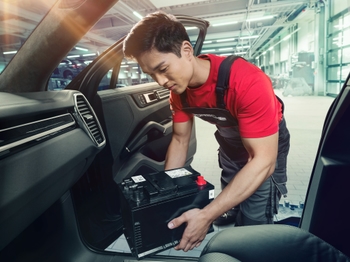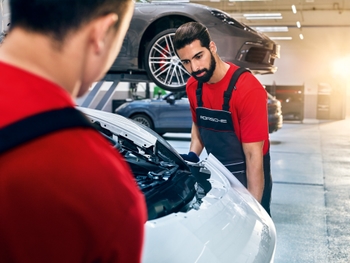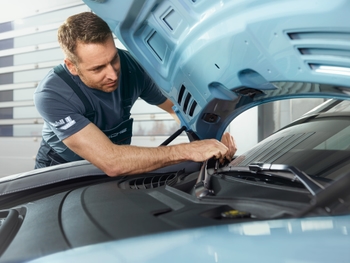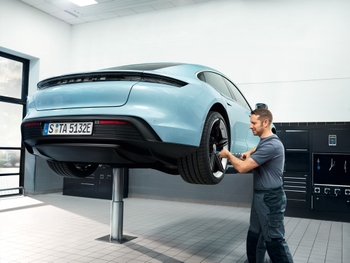
As the temperature continues to drop closer to zero, the time is now upon us for winter preparation of your Porsche. Even if you don’t winter drive your vehicle, there are some key steps you should take for any Porsche that lives in a cold-weather climate. As always, refer to your owner’s manual for specific information pertaining to your vehicle, however, a quick visit to our Service Department is still your best bet to winterize your Porsche.
There are some things that you can do before coming to see us (or give us a call and we can assist you with them too if you prefer).
Get your battery tested.
Cold weather is a stress test for your battery. There’s nothing worse than attempting to start your caron a cold winter morning and finding out your battery is dead. If you don’t have your own battery tester, most auto part stores will either test it for free for you or you can buy your own. Alternately, we can test your battery when you come in for service too. A quick search online will show you where to order your battery tester from. Once you receive your battery tester, you can also test the health of your alternator in addition to the charge of the battery itself. While you’re testing the battery, look at the battery terminals and verify that they are clean and not corroded. This is also a good time to check the date of when you purchase the battery. Once it reaches 3 years, don’t be surprised if you find yourself shopping for a new battery.
Lubricate.
Some areas that we tend to overlook when we consideration lubrication are the window tracks, door and trunk seals and hinges of our vehicles. Grease and oil have a tendency to thicken as the temperature drops further. Keeping your window tracks lubricated with silicon or dry Teflon will reduce the amount of work your window motors and regulators have to do. Apply silicon on the rubber seals of your door, hatch and trunks. This in turn will reduce the chance that water freezes the seal on the doors, hatch and trunks. In the case that water does freeze on them, it will seal shut or worse, rip off the rubber seal when you force it open. Use lithium grease on the hood, trunk and door hinges and latches. If your vehicle is equipped with visible door locks, use silicon inside of these to reduce the chance of them freezing.
Check your tires. I repeat. Check your tires.
There are a number of things that you need to check when it comes to checking your tires this winter. Firstly, check the proper tread depth (this means checking the inside, center and outside tread of the tires). You can use the simple penny test where you place the penny inside your tire tread with the Queen’s head upside down. If you see the top of the Queen’s head, your tires need to be replaced. If you’re running summer tires, you should look up the operating temperature limits. Depending on where you live, the temperature may drop below the operating temperature range of your summer tires which can make for dangerous driving conditions, longer distance required for braking and reduced traction/control of your vehicle. A great choice is to go with a set of winter tires that are engineered to work the same in lower temperatures. Winter tires aren’t necessarily snow tires as winter tires are meant to be driven in both cold and inclement winter weather vs. just snow. All of the major tire brands including Michelin, Pirelli, Bridgestone and more produce high performance winter tires for Porsche and all of the other major auto manufacturers.
Check your wiper blades.
This is a very simple fix. If your wiper blades are streaking/leaving a residue on the glass, making excessive noise, or simply deteriorating/falling apart, now is the time to replace them. Owning a vehicle in a place which has four seasons where frost, ice and snow are normal during the winter, takes a toll on your wipers. The extreme temperature changes speeds up the wear-and-tear and deterioration of the materials used which in-turn, requires them to be changed more frequently.
PCDT Video Tutorial on replacing wiper blades below.
Replace those dying hood struts.
If your hood struts were struggling during the summer months, they are definitely going to fail during the winter. Most hood struts are an easy, do-it-yourself type of job which you can handle from the comfort of your garage. If you’re not confident in your abilities, contact your Service Advisor at Porsche Centre Downtown Toronto and we can help you out.
Clean those drain tubes and radiator ducts.
Falling leaves, debris and basically anything small enough to clog drain holes can also block the deep recesses of where air conditioning condensers and radiators are mounted. When these areas get wet, they can cause the corrosion of these parts which eventually causes them to leak and require replacement which can get quite costly and pose danger to your engine’s performance. Most vehicles have drain holes where this water is supposed to run through while avoiding the interior of your car.
Many of the tips above are targeted towards individuals who work on their own vehicles regularly. Be sure to give us a call first anyways, especially if you aren’t used to working on your own vehicle regularly. We look forward to speaking with you very soon.




